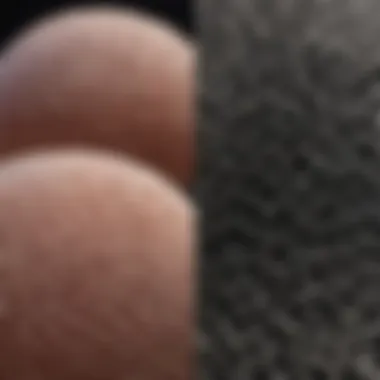Biodegradable Mesh Innovations in Hernia Repair


Intro
The field of surgical innovation continues to advance, particularly in the area of hernia repair. A significant recent development involves the introduction of biodegradable mesh materials. These meshes offer not only a practical solution for surgical procedures but also promise improvements in patient outcomes. Understanding the intricacies of biodegradable mesh, including its composition and performance, is essential for professionals involved in surgical practices.
As the medical community becomes increasingly focused on biocompatibility and sustainability, the relevance of biodegradable materials grows. This exploration addresses how these meshes differ from traditional synthetic options and their potential long-term benefits.
Investigation into the implications surrounding biodegradable meshes is particularly critical. By embracing new technologies, healthcare practitioners can improve patient recovery and reduce complications related to foreign implants. The following sections will delve into the key findings, methodology, and overarching implications of using biodegradable mesh in hernia repair.
Foreword to Hernias and Surgical Repair
Hernias represent a significant concern within the medical field, primarily due to their prevalence and the implications they carry for patients' health. A hernia occurs when there is a weakness or defect in the abdominal wall, allowing internal tissues or organs to protrude. This condition not only causes discomfort but may also lead to severe complications if left untreated. Understanding hernias and their surgical repair is vital for healthcare professionals, as it informs both treatment decisions and the patient's recovery journey.
Definition and Classification of Hernias
Hernias can be classified into several categories based on their location and cause. Common types include:
- Inguinal Hernia: Occurs in the groin area and is the most prevalent type among males.
- Femoral Hernia: Appears below the groin, often affecting females.
- Umbilical Hernia: Develops around the belly button, frequently seen in infants but can occur in adults.
- Incisional Hernia: Arises at the site of a previous surgical incision.
- Hiatal Hernia: Occurs when a portion of the stomach pushes through the diaphragm into the chest cavity.
Understanding these classifications allows for appropriate management strategies tailored to the patient's needs.
Traditional Approaches to Hernia Repair
Historically, surgical repair of hernias has relied on two main techniques: open surgery and laparoscopic surgery. Open surgery involves a larger incision, allowing the surgeon to access the hernia directly. This method has been a standard practice for many years, providing clear visibility of the repair site. However, it is associated with a longer recovery time and a higher risk of complications.
Laparoscopic surgery, on the other hand, employs smaller incisions and utilizes a camera to guide the procedure. This minimally invasive technique generally results in reduced postoperative pain, quicker recovery, and shorter hospital stays. Although effective, the choice between these methods depends on specific patient factors and surgeon expertise.
The Role of Surgical Mesh
Surgical mesh is an integral part of modern hernia repair procedures. It serves as a prosthetic implant that reinforces the abdominal wall, preventing the recurrence of hernias after surgical intervention. Traditionally, materials like polypropylene have been used to manufacture these meshes. While effective, concerns regarding chronic pain and foreign body reactions have prompted ongoing research and development into better alternatives.
By utilizing surgical mesh, surgeons can provide a more durable repair that withstands physical stress over time. This advancement is critical, considering that hernia recurrence poses a significant risk to patient outcomes. Understanding the nuances of surgical mesh, including its properties and potential impacts on healing, aids in delivering informed consent and optimal care.
Understanding Biodegradable Mesh Materials
Biodegradable mesh materials have gained attention in hernia repair due to their unique properties and benefits compared to traditional approaches. Understanding these materials is essential for grasping their role in modern surgical practices. Biodegradable mesh can significantly impact patient recovery. It aids in minimizing long-term complications related to foreign body reactions. This can lead to improved surgical outcomes and satisfaction for both patients and surgeons.
What Constitutes Biodegradable Mesh
Biodegradable mesh is designed to support tissue repair while gradually being absorbed by the body. This natural absorption process eliminates the need for additional surgeries to remove permanent mesh, reducing patient risk. The materials used in these meshes are often polylactic acid, polycaprolactone, and polyhydroxyalkanoates. Each of these polymers is chosen for its specific degradation rates and mechanical properties, ensuring they meet the clinical needs during the healing process.
Types of Biodegradable Polymers Used in Mesh
Polycaprolactone
Polycaprolactone is a polyester known for its flexibility and durability. It contributes to the overall performance of biodegradable meshes by providing a good balance between strength and elasticity. The key characteristic of polycaprolactone is its slow degradation rate, which is favorable for prolonged tissue support. This makes it a popular choice in applications where longer mechanical reinforcement is needed. One unique feature of polycaprolactone is its ability to maintain its mechanical properties over time, which can be advantageous in various surgical contexts. However, its slower degradation can also be seen as a limitation if quicker absorption is desired within specific clinical scenarios.
Polylactic Acid


Polylactic acid stands out due to its biocompatibility and biodegradability, playing a critical role in hernia repair. The key characteristic of polylactic acid is its ability to be synthesized in various forms, allowing customization for different surgical needs. This versatility makes it a beneficial choice in mesh production. A notable unique feature of polylactic acid is how it degrades into lactic acid, a naturally occurring substance in the body, promoting a safer environment for tissue healing. However, it may lose mechanical strength as it degrades, raising concerns about its long-term efficacy in some applications.
Polyhydroxyalkanoates
Polyhydroxyalkanoates are notable for their biodegradability and are produced by microbial fermentation. This aspect contributes to their overall environmental appeal alongside their application in hernia repair. The key characteristic of polyhydroxyalkanoates is their capacity to be tailored in their physical properties, which allows for a customizable solution for different surgical conditions. The unique feature of polyhydroxyalkanoates is their ability to provide an appropriate mechanical response during the healing process. However, accessibility and higher production costs can limit their widespread use in clinical settings.
Advantages of Biodegradable Mesh over Traditional Options
Biodegradable mesh presents several advantages compared to traditional mesh materials. Some include:
- Reduced risk of chronic pain: Since these meshes degrade over time, they may decrease the likelihood of long-term discomfort that often arises from permanent materials.
- Minimized surgical interventions: The need for additional surgeries to remove non-biodegradable mesh is eliminated, potentially decreasing overall healthcare costs.
- Enhanced biocompatibility: Many biodegradable materials are designed to integrate more seamlessly with biological tissues, promoting healing without significant immune response.
- Lower infection rates: As the body gradually replaces the mesh with its own tissues, the risk of infections associated with foreign objects may be lower.
Recent Advancements in Mesh Technology
Recent advancements in mesh technology represent a pivotal evolution in hernia repair practices. As the healthcare landscape constantly transforms, the integration of innovative materials and techniques into surgical procedures has become essential. The use of biodegradable mesh brings forth various benefits, including enhanced patient outcomes and a reduction in long-term complications.
Innovative Manufacturing Techniques
The production of biodegradable mesh has progressed significantly. Techniques such as 3D printing and electrospinning allow for greater customization of mesh structures, promoting better integration within the body. 3D printing enables surgeons to create meshes tailored to individual patient anatomy, enhancing surgical precision.
Electrospinning, on the other hand, helps in creating nanofibrous structures. This technique not only improves surface area for cellular adhesion but also influences the rate of biodegradation substantially. Innovations in these manufacturing processes are essential for achieving quality and functionality in biodegradable mesh made from polymers like polylactic acid and polyglycolic acid.
Enhanced Mechanical Properties of Current Biodegradable Mesh
The mechanical properties of biodegradable mesh have also seen enhancements. Modern designs ensure that the meshes possess adequate tensile strength while still allowing for flexibility. This balance is crucial because it aids in providing support during the healing process while reducing the likelihood of complications, such as chronic pain or mesh migration.
Research indicates that advanced mesh materials can withstand physiological loads without compromising their integrity. This is a significant improvement over traditional polypropylene meshes, which often exhibit issues related to elasticity and absorbable characteristics over time. Enhancing mechanical properties positively impacts recovery times and post-operative quality of life for patients.
Regulatory Considerations for Biodegradable Mesh Products
Regulatory frameworks play a vital role in the approval and utilization of biodegradable mesh products. The complexities involved in assessing biocompatibility and biodegradation rates necessitate rigorous evaluation standards. Key organizations, such as the U.S. Food and Drug Administration (FDA), focus on ensuring that new mesh products comply with safety requirements.
Compliance with these regulatory standards is necessary for gaining market acceptance. Also, manufacturers are encouraged to conduct thorough clinical trials to substantiate claims around efficacy and safety. The transparency of these processes is crucial in building trust among healthcare professionals and patients.
To summarize, the recent advancements in mesh technology reflect the commitment to improving surgical interventions for hernia repairs. With innovative manufacturing techniques, enhanced mechanical properties, and a robust regulatory framework, biodegradable mesh demonstrates the potential to revolutionize approaches to hernia management.
Comparative Analysis with Conventional Mesh
The significance of comparing biodegradable mesh to conventional mesh used in hernia repairs cannot be overstated. This analysis sheds light on critical elements such as patient outcomes, long-term effects, and cost considerations. Understanding these aspects fosters an informed debate among healthcare professionals and patients regarding the best options available, promoting enhanced surgical practices.
Patient Outcomes: Recovery and Complications
In examining patient outcomes, it is essential to consider how biodegradable mesh impacts the recovery process and potential complications. Studies have indicated that patients with biodegradable mesh report fewer instances of chronic pain compared to traditional polypropylene mesh. This can be crucial for improving the quality of life post-surgery.
Conversely, recovery times can be influenced by the characteristics of the biodegradable materials. The rate of degradation plays a role in how quickly the body can heal. An ideal biodegradable mesh should provide support initially and then gradually allow for tissue ingrowth. This balanced approach helps minimize complications associated with foreign materials, such as infections and inflammation.
Long-term Effects and Chronic Pain
Long-term effects are a major consideration in the choice between biodegradable and conventional meshes. Research indicates that the chronic pain associated with hernia repairs using traditional mesh can be significant. This pain often relates to the stiffness and permanent presence of synthetic materials in the body.


Biodegradable options, however, are designed to integrate more naturally with human tissue. They degrade over time, lessening the likelihood of chronic irritation. Evidence suggests that patients may experience a marked reduction in long-term discomfort with biodegradable meshes as their bodies reclaim the site of surgery without ongoing interference from a foreign body.
"The choice between biodegradable and conventional mesh can shape recovery trajectories and influence chronic pain management in hernia surgery."
Cost-effectiveness in Clinical Settings
Cost-effectiveness is an essential factor for both healthcare providers and patients. Many institutions are under increased pressure to allocate resources wisely. Biodegradable meshes typically come with a higher initial purchase price when compared to conventional options.
However, when evaluating the overall costs involved in patient care, biodegradable options may present financial benefits over time. Reduced rates of complications can lead to fewer follow-up surgeries and decreased hospital stays. This results in overall savings even if the upfront costs are higher.
Considerations also include the potential for improved patient satisfaction, which can influence hospital ratings and reimbursements. In the long run, integrating biodegradable technologies may prove beneficial not only to patient health but also to healthcare systems as a whole.
Clinical Implications of Biodegradable Mesh
Understanding the clinical implications of biodegradable mesh in hernia repair is crucial for modern surgical practices. These materials not only affect the surgical outcomes but also have long-term effects on patient health and recovery. The ability to adapt surgical techniques based on material properties can reshape the way surgeons approach hernia repairs. Surgeons need to weigh benefits against potential drawbacks when making decisions, which makes this topic vital for both the surgical community and patients.
Surgeons' Perspectives and Adoption Rates
Surgeons' perspectives on biodegradable mesh vary significantly. Many surgeons recognize the advantage of using absorbable materials, which reduce long-term foreign body response and potential complications such as chronic pain. However, the actual adoption rates can be influenced by various factors.
For instance, surgeons may show greater willingness to use biodegradable mesh if evidence supports its benefits over traditional non-absorbable options. Clinical evidence and personal experiences shape their comfort levels with this novel technology. Rates can also differ based on the specific material and manufacturer. Some surgeons might hesitate because of perceived limitations in mechanical strength or concerns about indeed degradation rates.
As with any surgical innovation, ongoing validation through studies and cases plays a role in increasing adoption rates. Such data can enhance surgeons' confidence in employing biodegradable mesh in procedure, ultimately improving patient outcomes.
Impact on Patient Decision-making
The introduction of biodegradable mesh changes patient decision-making processes. Patients are often more informed these days due to availability of information through different platforms. When discussing surgical options, it is essential for healthcare providers to outline the pros and cons of biodegradable mesh compared to traditional materials. This transparency enables patients to make choices based on a comprehensive understanding of potential outcomes.
Many patients prioritize minimizing future risks, like chronic pain or additional surgeries, and biodegradable mesh may align with these concerns. A patient's decision often involves factors such as:
- Informed consent on material properties.
- Understanding complications linked to long-term mesh presence.
- General sentiment towards synthetic materials.
Healthcare providers should strive to emphasize these points to guide patients towards making informed decisions, which enhances trust within the doctor-patient relationship.
Education and Training for Healthcare Professionals
For healthcare professionals, education and training regarding biodegradable mesh are imperative. Surgeons, nurses, and allied health professionals must be equipped with knowledge not just on the materials themselves, but also on emerging techniques and patient care protocols related to their use.
Specialized training programs can help bridge this gap. Essential elements in curriculum may include:
- Overview of biodegradable materials and their properties.
- Surgical techniques specific to biodegradable mesh application.
- Management of complications specific to these materials.
Courses could enhance healthcare professionals' competency and boost their confidence in choosing these advanced materials during surgeries. The better prepared they are, the more likely they are to adopt this innovative approach in their practices.
As surgical technologies continue to evolve, so too must the knowledge base of healthcare professionals involved in patient care.
Challenges and Barriers to Widespread Adoption
The adoption of biodegradable mesh in hernia repair surgeries, while promising, faces several challenges that hinder its full integration into standard medical practices. Understanding these barriers is crucial for stakeholders, including healthcare providers, manufacturers, and patients, as it impacts decision-making regarding surgical materials. Addressing these obstacles will enhance patient outcomes and increase the overall efficacy of surgical interventions.


Material Limitations and Biodegradation Rates
The properties of biodegradable mesh materials are essential for their success in surgical applications. Current materials, such as polycaprolactone and polylactic acid, have known benefits but also limitations. For instance, their strength and flexibility might not always meet the demands of high-stress surgical environments. Moreover, the rates at which these materials degrade can be inconsistent. If a mesh degrades too quickly, there may not be adequate support for tissue healing, leading to potential complications such as recurrence of hernias. Conversely, if the mesh remains in the body for too long, it may cause chronic inflammation or pain. The balance between support and biocompatibility thus becomes a primary concern.
Cost and Accessibility Issues
Cost is another significant barrier to widespread adoption. Biodegradable mesh materials often require advanced manufacturing processes, contributing to higher prices than traditional synthetic options. This increase in cost may limit accessibility for some healthcare systems, particularly in regions with constrained budgets. Patients seeking hernia repair may either face out-of-pocket expenses or may find that their insurance does not cover biodegradable materials. The financial implications can delay necessary medical procedures or drive patients toward more readily available but potentially less advanced options.
Need for Long-term Clinical Studies
Lastly, the necessity for long-term clinical studies cannot be overstated. While current research supports the effectiveness of biodegradable mesh, comprehensive studies over an extended timeframe are essential to fully understand the long-term effects on patient outcomes. These studies should address various factors, such as the rate of recurrences, complications associated with biodegradation, and overall patient satisfaction. The lack of extensive data makes healthcare professionals hesitant to recommend biodegradable options, impacting their adoption in clinical practice.
"Understanding these challenges is vital for advancing the use of biodegradable materials in surgical practices, ultimately benefiting patient care and recovery."
Culmination
In summary, the challenges and barriers to the widespread adoption of biodegradable mesh in hernia repair are significant but not insurmountable. Addressing material limitations, cost issues, and the need for thorough research will require collaboration between manufacturers, healthcare providers, and regulatory bodies. By tackling these challenges, the medical community can move closer to realizing the full potential of biodegradable mesh."
Future Directions in Biodegradable Mesh Research
The field of biodegradable mesh for hernia repair is evolving. As healthcare professionals seek to improve surgical outcomes, understanding the future direction of this area becomes crucial. There are specific elements worth considering, including emerging technologies, personalized solutions, and the potential for expanded applications. Each of these facets holds promise for enhancing patient care and clinical practices.
Emerging Technologies and Innovations
Advancements in materials science are paving the way for innovative biodegradable meshes. New manufacturing methods, such as 3D printing, are leading to customizable and complex mesh designs that can better meet the specific needs of various patients. Researchers are now exploring novel polymers that offer enhanced strength and more predictable degradation rates. This evolution allows for better integration with the human body and potentially minimizes complications during the healing process.
Furthermore, nanotechnology is opening doors to increasing the functionality of these materials. By incorporating nanoparticles, meshes can provide additional antibacterial properties, which can reduce infection risks post-surgery. These innovations reflect a shift toward more sophisticated materials that minimize the body's inflammatory response and improve recovery times.
Personalized Medicine and Customizable Mesh Solutions
The concept of personalized medicine is gaining traction in the development of biodegradable mesh solutions. Each patient's anatomy and biological response can differ significantly. Customized meshes can be engineered to fit individual patient profiles. This level of personalization allows for a tailored surgical approach, potentially improving outcomes and reducing the risk of recurrence after hernia repair surgery.
Additionally, the concept of dynamic mesh design, where the mesh evolves with the patient’s healing process, is in its infancy but shows massive potential. With continuous monitoring and feedback mechanisms, these adaptable meshes could adjust their properties based on the healing progress, providing ongoing support and lessening the chances of chronic pain or complications.
Potential for Other Surgical Applications
Beyond hernia repair, biodegradable mesh materials hold promise for use in other surgical applications. Their versatility could extend into fields like orthopedic surgery, where they might help in reconstructing damaged tissues. Researchers are investigating how these materials could serve as scaffolds for tissue engineering, promoting cell growth and integration with surrounding tissues.
Moreover, there is an interest in utilizing biodegradable meshes in procedures involving soft tissue reconstruction. This could be especially valuable in cosmetic and reconstructive surgeries, where integration and minimizing foreign body response are critical factors.
In summary, the future of biodegradable mesh research seems bright, with several exciting avenues for exploration. Emerging technologies are transforming materials, personalized medicine is reshaping surgical approaches, and the potential applications are expanding continuously. These advancements will likely confront the existing challenges and enhance the quality of care in surgery.
Finale
The conclusion serves as a pivotal element in this article, summarizing not only the key takeaways but also the broader implications for the future of hernia repair. As the utilization of biodegradable mesh materials becomes increasingly prevalent, it is essential to appreciate the advancements these innovations bring to surgical practices. The mesh's biocompatibility and its ability to integrate into the body offers significant advantages compared to traditional options. This transition marks a significant shift in patient management and recovery outcomes.
Summary of Key Findings
- Biodegradable mesh materials have demonstrated superior biocompatibility, significantly reducing the risk of complications compared to conventional permanent meshes.
- Innovations in material science have improved the mechanical properties of biodegradable mesh, addressing previous limitations and enhancing performance in surgical settings.
- Patient recovery and long-term outcomes have shown promising results, with lower instances of chronic pain and fewer complications reported in studies comparing biodegradable and traditional meshes.
- Cost-effectiveness remains a crucial point; while initial costs may be higher, the reduction in follow-up care and complications might offset this in the long run.
Recommendations for Future Research
To further enhance the understanding and application of biodegradable mesh in hernia repair, the following areas require more thorough investigation:
- Long-term clinical studies are essential to assess the durability and performance of biodegradable mesh over extended periods.
- Exploration of customizable mesh solutions tailored to the unique anatomy of individual patients can pave the way for more effective outcomes.
- Innovations in biodegradation technologies, targeting controlled degradation rates, would optimize healing processes and improve surgical results.
- Comparative studies across diverse patient populations will help clarify the benefits of biodegradable mesh in different demographics and health conditions.



